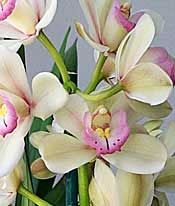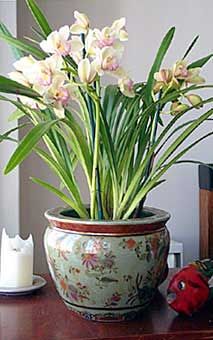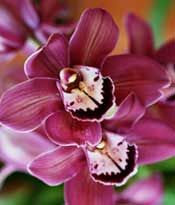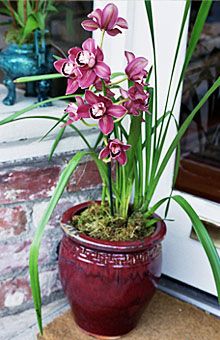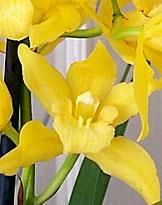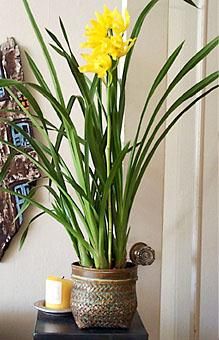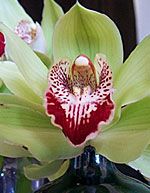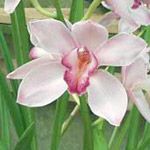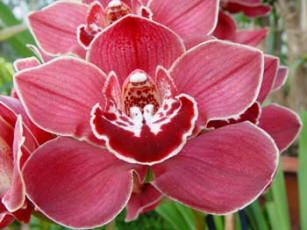Cymbidium
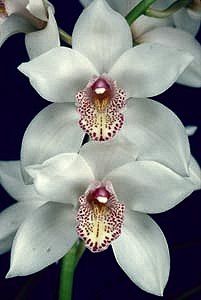
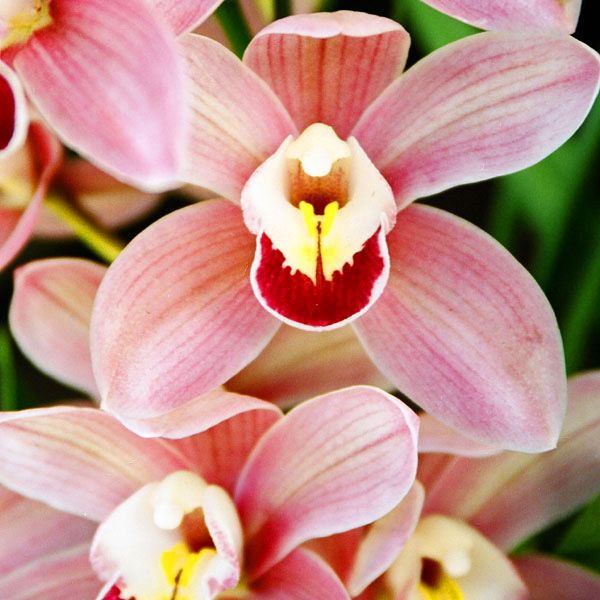
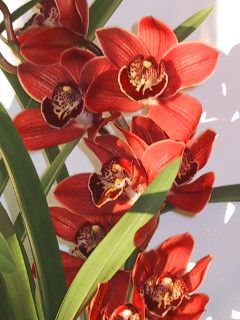
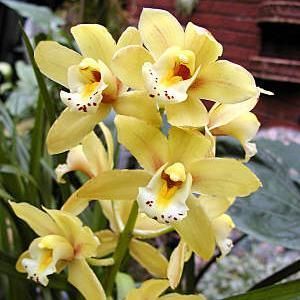
Height: up to 90 cm (3 ft)
Spread: up to 90 cm (3 ft)
Form: mainly epiphytic
Soil: Very free draining orchid compost
Light: Dappled shade to full sun
Description:
Originating in temperate and tropical parts of India, Nepal, China, Japan and down to Malaysia and Australia, cymbidiums are probably the most widely grown of all orchids because of their ease of cultivation and long-lasting flowers. From the 40-50 species, thousands of hybrids have been bred, with flowers ranging in colour from white, yellow and orange to pink, red, brown and green, and varying in size from 5-10 cm (2-4 in) across.
Cymbidiums figure in the earliest historical records of human association with orchids from China and Japan. These include Chinese folk songs composed before the time of Confucius (551-479 BC). The first written work on orchids was published in China in 1233 AD and listed 22 orchids with descriptions. The first systematic description and classification of the genus occurred when Olaf Swartz established it formally in 1799.
The first cymbidium was introduced into England by James Fothergill from China in 1778 and the first cymbidium hybrid was bred in 1889.
The name Cymbidium comes from the Greek word kymbe meaning boat, from the hollow recess in the lip of the flower.
|
Pagoda Green Cymbidium |
|
Cymbidium hybrids
Incredibly no more than seven or eight species have been responsible for 90 per cent of the thousands of Cymbidium hybrids we have today. During the 1930's and 40's many popular hybrids were bred in America, though by 1960 there was a transition to a dominance of British-bred hybrids.
Cymbidium hybrids can be split into three groups, standard hybrids, miniature hybrids and novelty hybrids, which are sometimes called intermediate hybrids. Standard hybrids grow into large plants and take up a great deal of space. Most flower in late winter and spring for up to two months and are available in almost every colour except blue. Miniature hybrids have been bred from dwarf species such as C. devonianum and C. tigrinum. While the colour range is limited to green, yellow or brownish flowers, some are pleasantly scented. Novelty hybrids result from crosses between miniature and standard hybrids and are some of the best modern hybrids available.
The leaves of standard cymbidiums are strap-like, upright or pendulous and 50 cm (20 in) or more in length, with those of miniature plants being much narrower and shorter.
With careful selection it is possible to have a collection of cymbidiums flowering all year around. Flowers are borne on sturdy stems well clear of the foliage many will last up to two months either on the plant or as a cut flower.
|
Festive Red Cymbidium |
|
Cultivation
Cymbidiums require a heated environment during the winter, though they can benefit from being placed outside during the summer. To initiate flowering many hybrids require a drop in night temperature and they will also not flower if they do not get sufficient light.
Cymbidiums must be potted with the base of the pseudobulb at or just above the level of a very free-draining potting mix in a well drained container. Cymbidiums are quite vigorous and may need dividing and repotting every two or three years into 20 cm (8 in) containers.
The level of watering is determined by the time of year. During the summer plants may need watering daily but during the winter this could reduce to once every two weeks. The compost mix should be kept moist and enough water given at each watering for water to pour through the mix.
Temperature: A minimum night temperature of 10-14�C (50-57�F) is required. It helps if plants have a spell outdoors from June to September to encourage flower-bud initiation. Gradually acclimatise plants to sunlight to prevent leaf scorch. While spikes are developing, night temperatures must fall below 15�C (60�F).
Flowering: This can occur from November to May with flower spikes lasting roughly eight weeks. Support developing spikes with a cane, and cut them down to 5cm (2in) when blooms have faded.
|
Golden Buddah Cymbidium |
|
Watering and feeding: From spring to autumn, water from above and allow excess water to drain away; compost should just dry out between waterings. Moderate feeding during the growing season is beneficial. Use a general purpose liquid feed at half strength every third watering. Then use only water the fourth time to ensure that harmful salts are washed out. In winter, reduce the watering and allow plants to dry out for a time.
Re-potting: Re-pot congested plants after flowering in spring. Don't overpot plants. Some of the old pseudobulbs that have lost their leaves can be removed. Use a specially formulated orchid compost which is available at larger garden centres and specialist nurseries. When dividing plants, ensure that there are at least three or four healthy pseudobulbs per division.
Pestes and diseases
Cymbidiums are prone to many of the common glasshouse pests, including red spider mites, aphids, whiteflies and mealybugs. Virus diseases can also be a problem which can be avoided by disinfecting tools and equipment to stop it spreading.
Propagation
In addition to regular division new plants can be grown from the older, leafless bulbs. These backbulbs may look dead but they will regrow if they are detached from the younger plants. Plant the bulbs into small individual pots filled with a coir compost and bark mix and keep damp. Once good leaf and root growth are evident they can be potted into a normal orchid compost. Backbulbs will generally flower after three years.
|
|
|
|
Articole asemănătoare
-
Decor interior la inceput de toamna
Alegeti plante cu flori sau fructe frumos colorate ori exotice orhidee, considerate uneori, in mod exagerat, greu de ingrijit.
-
Secretele designului - trunchiul pentru plante epifite
In padurile ecuatoriale intalnim plante care, pentru a putea beneficia de lumina prezenta in coroana arborilor, s-au adaptat la traiul ''la inaltime''. Ele traiesc pe crengile groase ale acestora, la ingemanarea mai multor ramuri, acolo unde cu timpul se formeaza un strat foarte subtire si ingust de pamant, provenit din descompunerea frunzelor moarte.
-
Dendrobium
Denumire populara: orhidee Dendrobium, orhidee de Singapore. Denumire stiintifica: Dendrobium sp. Familie: Orchidaceae. Dendrobium formeaza cel mai mare grup de orhidee, care contine mai mult de 1500 de specii si probabil...
-
Gradina Chinezeasca din Portland
In urma unei idei rasarite in 1985 a luat fiinta, in septembrie 2000, Gradina Chinezeasca din Portland, sau Lan Su Yuan (Gradina Orhideelor Trezite). Gradina este amenajata in stilul dinastiei Ming, cu alei lungi, poduri...
-
Despre orhidee. Cymbidium.
Familia: Orhidaceae Originare din zonele cu clima temperata si tropicala din India, Nepal, China, Japonia si pana in Malaysia si Australia, cymbidium sunt probabil cele mai mult cultivate orhidee...
